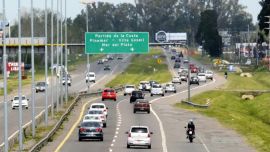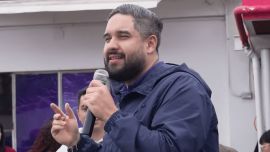The two chalets are identical. They have two bedrooms, a bathroom and a kitchen, although in different corners of the Zárate naval base. Visits thus needed good logistical coordination – who prepared the meal, who lined up the drinks and in which house they met up.
Alfredo Astiz dropped by the place of Alberto González, like the oldest of friends which they were. Both graduated from the Naval Academy in its centennial year, beginning their studies in 1968. Some years later their paths crossed again at the ESMA (Escuela de Mécanica de la Armada) naval engineering academy. They were no longer young students but two central cogs in a bloodthirsty machinery that ground up 5,000 persons with only a few survivors. During the dictatorship they clashed – both were in love at the same time with the same woman, a 20-year-old Montonera held at ESMA. It was González who came out on top and not from the choice of the girl, who was systematically violated and tortured by him.
But all that is an old story. Now they have other problems - Néstor Kirchner has become president, the “Due Obedience” and “Full Stop” laws have been quashed and the trials for crimes against humanity have been revived. Now Astiz and González are both remanded in custody for the abductions, tortures and forced disappearances in which they participated.
Nevertheless, thinks Astiz as he opens González’s door at the Zárate base, things are not so bad. At least they are permitted to receive anybody they like to pass a pleasant evening as he is about to spend as a protagonist. That was what was in his head when Victoria Villarruel came out of the kitchen and tells him what he can already smell: that dinner is about to be served.
It is 2005. As he eats, Astiz listens to the idea of González to create a civil society association to speak of “the other dead,” providing a “complete memory” of the 1976-1983 military dictatorship and the years leading up to it. Seated next to the host, Villarruel takes note in silence.
Identikit
Alberto Eduardo González was born on October 26, 1950, in the Federal Capital, the son of Francisco Alberto and Inés Edith Di Lorenzo. ‘El Gato’ (“the cat”), as he was called in the “leaden years” of the dictatorship, is a retired naval lieutenant-commander and a professor of naval history.
But that’s not all that’s in his biography. He was also an intelligence officer in the Grupo de Tareas 3.2.2 task force ESMA, commanded by Jorge ‘El Tigre’ (“the tiger”) Acosta, one of the most notorious and feared repressors of those grim years. González was at ESMA in that capacity between March 1, 1977 and May 17, 1979. Astiz was also a member.
That task force is not just another page. It occupies a central place in the saddest period of Argentine history, forming a key part of what was known as the “death flights.” In its grounds for the later sentencing González to life imprisonment for crimes against humanity, the court’s judges described this group thus: “It carried out offensive operations: i.e. going out to detain those suspected –according to them– of links with 'subversion' or 'terrorist organisations,' processing the data. Such offensive operations comprehended the cycle of detention, interrogation, imprisonment and final resolution of the case, i.e. abduction, torture and being deprived of liberty in a clandestine detention centre, ending in death or forced disappearance.”
González held a distinguished position within that sanguinary machinery, or at least he managed to convince Emilio Massera of that – on September 12, 1978, the Navy commander–in-chief decorated him for “honourable valour in combat” to “reward heroic deeds” in “real combat operations.”
Yet while ‘El Gato’ did indeed participate in organising the abductions and the operations as such, his terrain lay elsewhere in the “basement,” the most terrifying corner of ESMA. That was the first place where the military sent the abducted for torture and where there were tiny cells where the detained were held in inhuman conditions. “The basement” was also the last place seen by thousands of those missing sent there prior to being murdered.
In that piece of hell, the strings were pulled by Alberto González, who was in charge of “the cases,” as they said at ESMA. “His specific role consisted in obtaining information via torture and planning the use of that information,” reads the verdict that convicted him.
González’s terrain lay elsewhere in the “basement,” the most terrifying corner of ESMA … it the last place seen by thousands of those missing sent there prior to being murdered.
Montonero Silvia Laybarú, 20, five months pregnant, had the misfortune of ending up there. González and Astiz both fell for her and competed as to who would be the first to take her by force.
As Laybarú relates in a chilling narrative in a book about her, ‘El Gato’ not only raped her at ESMA, he did so with phenomenal violence due to having developed feelings towards her. From the basement he took her home where he repeated that operation but with a further macabre twist, involving his then wife. That happened with their two-year-old daughter in the next room.
“At first I took it as part of the torture but always clear that being obliged to participate in the erotic games of that couple made me see very clearly that what those people were doing had absolutely nothing to do with the struggle against subversion. How does being raped by an officer’s wife serve that struggle, what does it have to do with it? They are so Christian, so ethical ... why does being raped by a naval officer’s wife serve [towards that]?” she said in an interview with Perfil newspaper accompanying the launch of the book written by Leila Guerreiro about her and her story, La llamada.
Today González is serving three life sentences in prison: one in the ESMA II case for his role in the disappearance of 86 persons, in the ESMA III case for a further 789 victims, and finally for the rape of Laybarú and two other women. On August 15, 2021, a court in Argentina made González the first figure of the military dictatorship to be convicted for sexual offences.
But ‘El Gato’ is not only that, he is also the mentor of Argentina’s current vice-president.
The dark side
“Of all the former ESMA people with whom Villarruel could have mixed up, González is the worst,” says journalist Uki Goñi, the author of El infiltrado, the book about Astiz which was central to the trial convicting both, Within it “González Menotti,” another of his nicknames, often appears.
Villarruel got to know González via another person who was “proud” of having participated in the “struggle against subversion,” as he called it, and who was later also decorated for his work: her father Eduardo Villarruel.
Villarruel Snr and González shared a love of history (‘El Gato’ studied that subject during years of democracy at the University of Belgrano, of which Javier Milei is also a graduate, curiously enough). Both liked naval history in particular. In 1989, reports journalist Ricardo Ragendorfer, González was appointed chief researcher of the Department of Historical Studies.
González’s influence on Villarruel is huge. “He’s like my second father,” she is reported to have said within her intimate circle. Several others also testify to that effect.
“I got to know him [González] through Villarruel. We went together to the prison and he showed the book he was writing, which Victoria later signed,” related Cecilia Pando, another woman of this military world.
This leads to another story – both on and off the record, many hint that the books which the vice-president previously published as hers (Los llaman jóvenes idealistas and Los otros muertos) were not of her own authorship.
“Alberto trained Victoria and wrote the books which she signed as her own,” assures Segundo Carafí, a leader of Juan José Gómez Centurión’s NOS party, which Villarruel briefly joined and of which her sister and mother were card-carrying members.
This commentary was seconded on social networks by Nicolás Marquéz, one of the President’s preferred ideologues. In private the writer of Libro negro de la nueva izquierda is cruder – he assures that Villarruel and González were previously a couple.
Another important person from the group of the relatives of imprisoned military officers says the same, while insisting on turning the tape-recorder off.
“I went to visit Alberto several times in prison when he was writing those books. Victoria only went when Alberto’s wife was not there. Villarruel’s CELTYV foundation was Alberto’s work, it was always his idea to tell the whole picture,” they said.
Those close to the vice-president affirm that the books were authored by her. They prefer not to comment on the link with González. One fact does not cease to be curious: Villarruel has published two books with hundreds of pages, but she has never stood out for even writing articles.
At present
From the naval base in Zárate, González was transferred to Marcos Paz prison and then to jail in Ezeiza where he is detained today in prison complex VII with Astiz and others convicted of crimes against humanity.
Villarruel stays in contact with him through to today, affirmed relatives of the prisoners held there, as well as two of her ex-aides.
“Whenever in doubt and over any important issue, Victoria communicates with him. He’s kind of a guide for her,” they assure.
“Villarruel’s CELTYV foundation was Alberto’s work, it was always his idea to tell the whole picture.”
Other murky figures are also present near the vice-president. This newspaper has revealed that the repressor Luis Patti, who is serving three life sentences for abductions and murders, put money into her first campaign with Milei. Another was Raúl Granillo Ocampo, Carlos Menem’s Justice minister who was the author of pardons for almost 200 Armed Forces officers accused of crimes against humanity. As a national deputy, Villarruel had Marcelo Cinto Courtoix Junior, the son and namesake of another dreaded repressor, as an advisor.
Página/12 journalist and Times contributor Luciana Bertoia has revealed that since becoming vice-president, Villarruel contracted María de las Mercedes Torres – the daughter of Fernando Torres, who was sentenced to life imprisonment for his crimes in Tucumán during the dictatorship – to work with her at the Senate, along with María Guadalupe Jones, the daughter of Juan Carlos Jones Tamayo, another sentenced to life imprisonment for crimes against humanity.
Another major question floats over this story as the first March 24 anniversary of the Milei-Villarruel administration passes: What was the real link between the current vice-president and ex-Junta leader Jorge Rafael Videla, the man who triggered the coup on that very date?
On the same occasion on which Pando revealed that she had got to know González via Villarruel, she added another detail – that she had met Videla thanks to her.
Pedro Mercado, Pando’s husband and a retired military officer, also published a long letter on Facebook where, among other topics, he talked about that meeting. According to his account, the vice-president was a kind of secretary for the dictator, organising meetings with him from outside prison.
Villarruel has denied this version of events, assuring that she had seen Videla “twice at most, perhaps three times” and that had been to “interview him” for her book Los llaman jóvenes idealistas. Yet this rebuttal poses major questions. One is almost naïve: is it possible to meet somebody like Videla without remembering exactly how many times? Is sitting face-to-face with the bloodiest dictator in Argentine history so forgettable?
But there is also another question too. Noticias has access to the first edition of Villarruel’s book, published in 2009. The number of mentions of Videla within it is zero, not a single one. And not only that – the book ends with the 1976 coup. If Villarruel used her chat with Videla as off-the-record information without naming her source, that contradicts the idea of “interview” according to her own assurance, which implies the testimony to be on the record. There is, it is true, another 2018 edition, which is sold out and impossible to obtain. Are the interviews with Videla to be found there? That would be striking… bearing in mind that he died in 2013.
There is still plenty of mystery about the story between Villarruel and some of the most feared figures from the 1976-1983 military dictatorship.


























Comments